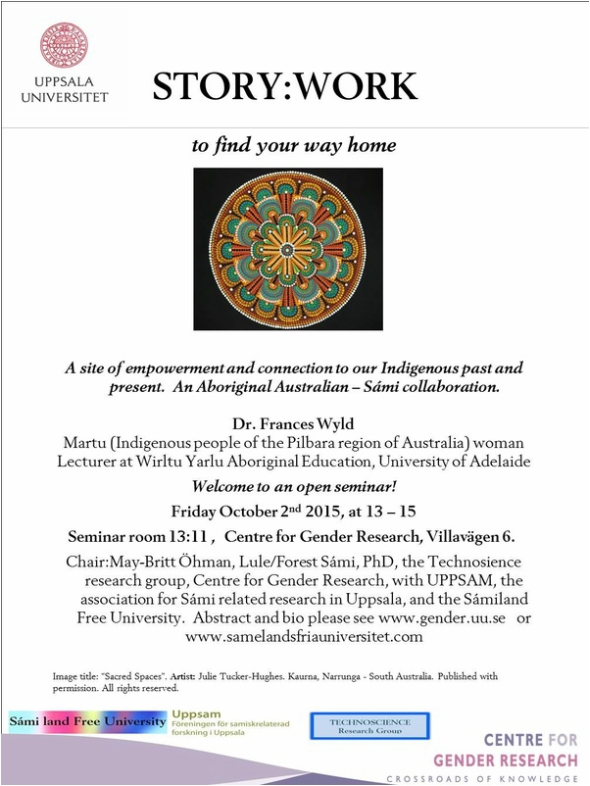STORY:WORK to find your way home. Seminar Oct 2nd Uppsala, Centre for Gender Research. Frances Wyld14/9/2015
Frances Wyld
Seminar Oct 2, 2015, 13-15 Centre for Gender Research, Uppsala University For explanation of art, please scroll down. Storytelling: a site of empowerment and connection to our Indigenous past and present Abstract Dr Frances Wyld first visited Uppsala University to participate in the first supra-disciplinary symposium run by Dr May-Britt Öhman where she presented her creative thesis-in-process on Indigenous research methodologies storied alongside a narrative of survival as an Indigenous feminist in academia. This life writing experiment is now finished and the presenter did indeed survive and found a way to include storytelling as a site of empowerment and as a connection to the past and present. This is seen in her publications (Wyld, 2015; Öhman & Wyld, 2014; Wyld, 2012, 2011; Somerville, Somerville & Wyld, 2010) and in her work as a curriculum designer and developer within her work as lecturer. Her research is a focus on the storytelling conventions of mythography (Campbell, 1975), Indigenous Storywork (Archibald, 2008; Martin, 2008), auto-ethnography (Richardson, 2005) and semiotics (Barthes, 1972; Kristeva, 1980) in practise. Within this life writing experiment the ability to communicate metaphorically surfaced. Metaphor as trope has been used for millennia by Indigenous peoples (Cajete, 1999) for storytelling and as a site of empowerment and connection to past practises for communicating Indigenous knowledges. Biography Frances Wyld is a Martu (Indigenous people of the Pilbara region of Australia) woman and lecturer at Wirltu Yarlu Aboriginal Education at the University of South Australia. She has recently finished a Doctor of Communications with a thesis titled ‘In the Time of Lorikeets: Storywork as an academic method’. Her interest is in applying Indigenous research methodologies and pedagogies within a university setting taking a cross-discipline approach that includes cultural studies, education, history and philosophy. Selected Publications Wyld, Frances and Fredericks, Bronwyn (2015) ‘Earthsong as Storywork: Reclaiming Indigenous Knowledges’ in Journal of Australian Indigenous Issues (forthcoming). Öhman, May-Britt. and Wyld, Frances (2014) ‘Lands of Fire and Ice; from Hi-Story to History in the Lands of Fire and Ice: Our stories and embodiment as Indigenous in a colonised hemisphere’ in V. Castejon, A. Cole, O. Haag, and K. Hughes, (eds.) Ngapartji Ngapartji Reciprocal Engagement: Ego-Histoire, Europe and Indigenous Australia, Australian National University E Press, Canberra. Wyld, Frances (2012) 'Knowing the State We're In: Indigenous motherhood as a human right' http://www.maramatanga.ac.nz/sites/default/files/NPM%20Conference%20Proceedings%202012.pdf Wyld, Frances (2011) ‘Writing the Ephemeral of Culture: Storm Method’ in Social Alternatives 30 (2) 40 - 43 Wyld, Frances (2011) ‘Experiment on a bird in the air pump: The writing of a life under pressure’ in the Journal of Australian Indigenous Issues 14 (1) 54 - 62 Somerville, Craig, Somerville, Kirra, and Wyld, Frances (2010) ‘Martu Storytellers; Aboriginal narratives within the academy’ in The Australian Journal of Indigenous Education, 39S, 96 - 101 Explanation of art: Sacred Space (2013) Sacred Space does not only refer to the sacred country that we gathered on for ceremony, it also refers to the sacred inner space that as Aboriginal people, we have. It is where our connection to each other and our country and culture lays. The layers of dots spreading outwards represents our journey from birth across country; always connected to it - that is where our culture is. It is our spiritual womb that nurtures us and provides for us. The outer layers represent our ancestors watching over us and guiding us outwards to eternity - Our ancestors are always with us. Artist: Julie Tucker-Hughes. Kaurna, Narrunga - South Australia Published with permission. All rights reserved. Översättning till lulesamiska av Samuel Gælok Mijá åssko ij la dåssju basse saje gånnå mij æjvvalip basodimijda. Dási gullu aj mijá sissŋálasj vuojŋŋa mij midjij álggoálmmugij ednamij ja viessomij le ávkken. Dá li midjij aktijvuohtan gaskanimme ja mijá viessomij. --- Mijá ájttega li mijáj siegen iehkeva ájggáj. Översättning till svenska av May-Britt Öhman ”Heliga platser” innebär inte bara de platser vi samlas på för ceremonier, det innebär även de heliga inre platser som vi som urfolk har. Det är här vår anknytning till varandra, vårt land och vår kultur finns. --- Våra förlevande är alltid med oss.
0 Comments
Your comment will be posted after it is approved.
Leave a Reply. |
För inlägg på bloggen ansvarar respektive undertecknad skribent.Samelands fria universitet har inga egna åsikter utan utgör en plattform för visioner och diskussioner. Kommentarer till och svar på blogginlägg publiceras efter granskning. Du är varmt välkommen med inlägg även till vår gästblogg. Categories |
||||||

 RSS Feed
RSS Feed